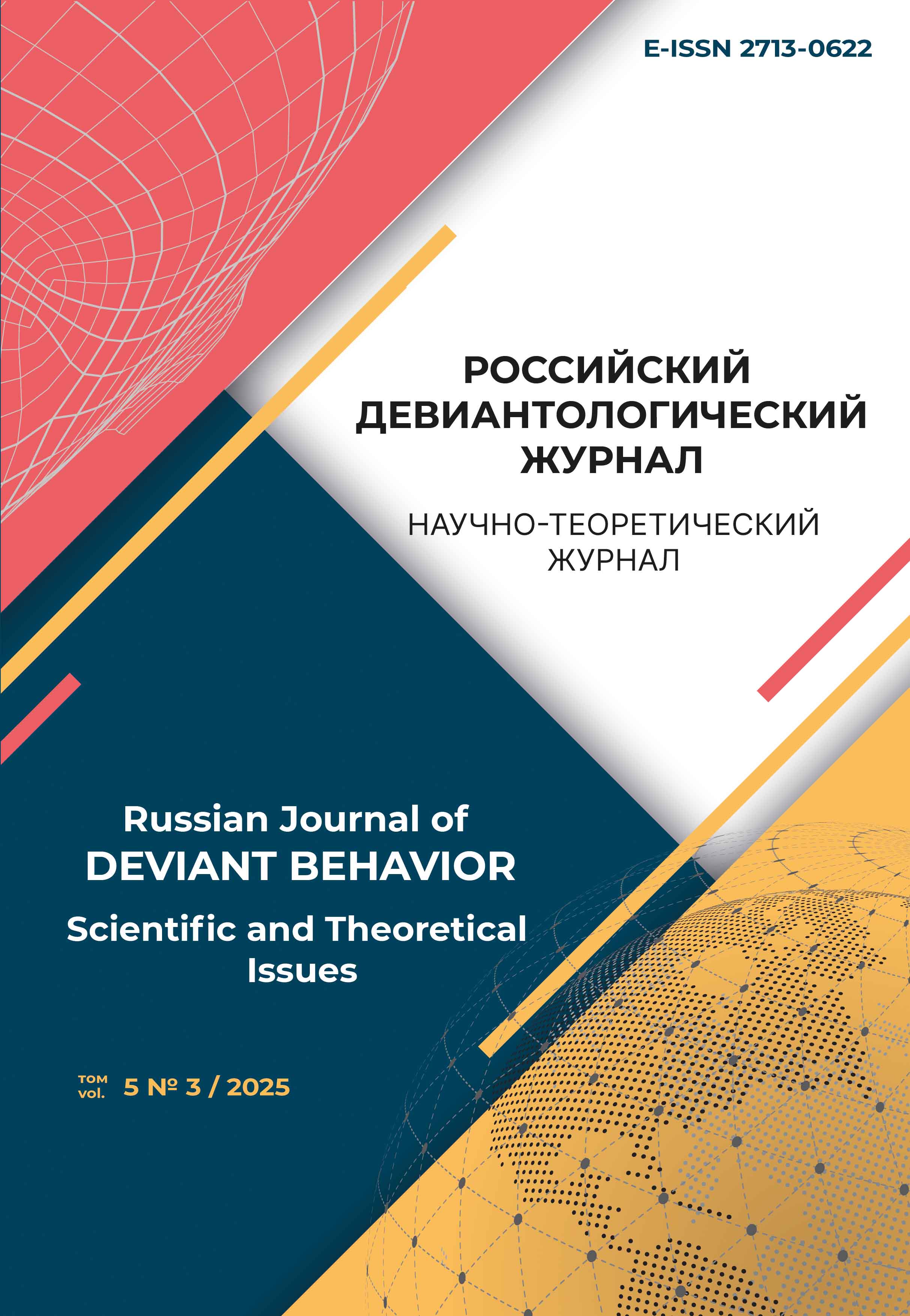Russian Federation
Saint Petersburg, St. Petersburg, Russian Federation
Russian Federation
UDC 159.99
Introduction. The article reveals the role of shame and guilt in regulating the behaviour of individuals who demonstrate a tendency towards self-harm. Research methods. In order to solve these tasks, the authors used methods such as the Guilt Questionnaire by K. Kugler and W. H. Jones, the Feelings and Emotions Questionnaire (PFQ2), the Emotion Regulation Scale (DERS-16), the brief version of the Personality Disorder Inventory for DSM-5 (PID-5-BF), and the Auto- and Heteropression Questionnaire (E. P. Ilyin). Results. The authors present the results of a comparative empirical study of young women (average age 22.5 years) in three groups with a total of 139 participants: a group of individuals engaging in non-suicidal self-harm, a group of individuals suffering from eating disorders (EAD) (prone to modifying their bodies through fasting and following special diets), and a control group of young women with no behavioural abnormalities. The results of the study lead to the conclusion that young women prone to self-harming behaviour experience intense feelings of shame and guilt more often than respondents in the control group, choose maladaptive methods of emotional regulation, and are prone to autoaggression. In both groups of respondents prone to self-harm, feelings of shame and guilt are closely linked to maladaptive methods of emotional regulation, dysfunctional personality traits, and self-directed aggression.
emotions of shame and guilt, self-harming behavior, dysfunctional personality traits, autoaggression
1. Akopyan, L. S. (2019). Emocional'nye sostoyaniya kak determinanty suicidal'nogo povedeniya podrostkov. Povolzhskij pedagogicheskij vestnik, 7 (1 (22)), 24–28.
2. Alimov, A. A. (2013). Fenomeny styda i viny kak regulyatory social'nogo povedeniya individa v izmenyayushchemsya obshchestve. V Sovremennye problemy i perspektivy razvitiya pedagogiki psihologii: sbornik materialov 2-j mezhdunarodnoj nauchno-prakticheskoj konferencii (Mahachkala, 30 sentyabrya 2013 g., str. 109–111). Mahachkala: Obshchestvo s ogranichennoj otvetstvennost'yu «Aprobaciya».
3. Antohina, R. I., Antohin, E. Yu. (2021). Emocional'nye skhemy u podrostkov s suicidal'nymi popytkami. Psihiatriya i psihofarmakoterapiya, 23 (1), 16–19.
4. Bazhenova, L. V., Garashchuk, S. S. (2021). Rol' chuvstv viny i styda v razvitii narushenij pishchevogo povedeniya (v kontekste krizisa srednego vozrasta). Naukosfera, 3-1, 79–83.
5. Belik, I. A. (2006). Chuvstvo viny v svyazi s osobennostyami razvitiya lichnosti: avtoref. dis. … kand. nauk. Saint Petersburg.
6. Vasil'eva, O. S., Korotkova, E. (2004). Osobennosti perezhivaniya viny v sovremennom obshchestve. Konsul'tativnaya psihologiya i psihoterapiya, 12 (1), 48–73.
7. Gorbatov, S. V., Arbuzova, E. N, Abramovich, E. M. (2021). Regulyaciya povedeniya u molodyh zhenshchin, praktikuyushchih samopovrezhdenie. V Anan'evskie chteniya – 2021: materialy mezhdunarodnoj nauchnoj konferencii (Sankt-Peterburg, 19–22 oktyabrya 2021 g., str. 875–876). Saint Petersburg: OOO «Skifiya-print».
8. Gornaeva, S. V. (2012). Vina i styd v kontekste psihologicheskoj regulyacii social'nogo povedeniya lichnosti. Mir nauki, kul'tury, obrazovaniya, 2 (33), 47–49.
9. Zajchenko, A. A. (2009). Samopovrezhdayushchee povedenie. V E. V. Burenkova (red.), Psihologiya telesnosti: teoreticheskie i prakticheskie issledovaniya: sbornik statej (str. 191–195). PsyJournals.ru.
10. Il'in, E. P. (2017). Psihologiya sovesti: vina, styd, raskayanie. Saint Petersburg: OOO Izdatel'stvo «Piter».
11. Kochnova, E. N., Merinov, A. V., Volodin, B. Yu., Novikov, V. V. (2023). Autoagressivnye harakteristiki yunoshej i devushek, ispytyvayushchih otchyotlivye perezhivaniya styda sobstvennogo tela. Suicidologiya, 14 (1 (50)), 101–114. doi.org/10.32878/suiciderus.23-14-01 (50)-101-114)
12. Kustov, G. V., Zinchuk, M. S., Pashnin, E. V., Vojnova, N. I., Popova, S. B. i dr. (2022). Izuchenie psihometricheskih harakteristik russkoyazychnoj versii oprosnika PID-5-BF. Psihologiya. Zhurnal Vysshej shkoly ekonomiki, 19 (3), 521–542.
13. Lebedinskij, V. V., Nikol'skaya, O. G., Baenskaya, E. R., Libling, M. M. (1990). Emocional'nye narusheniya v detskom vozraste i ih korrekciya. Moskow: Izdatel'stvo MGU.
14. Levkovskaya, O. B., Shevchenko, Yu. S., Danilova, L. Yu., Grachev, V. V. (2017). Fenomenologicheskij analiz nesuicidal'nyh samopovrezhdenij u podrostkov. Zhurnal nevrologii i psihiatrii im. S. S. Korsakova, 117 (7), 10–15. https://doi.org/10.17116/jnevro20171177110-15
15. Lezhenina, T. I. (2021). Osobennosti emocional'noj sfery sklonnyh k suicidu podrostkov. V V. A. Lipatov (red), Nauchnaya iniciativa v psihologii: mezhvuzovskij sbornik nauchnyh trudov studentov i molodyh uchenyh (str. 108–112). Kursk: Kurskij gosudarstvennyj medicinskij universitet.
16. Makogon, I. K., Enikolopov, S. N. (2015). Aprobaciya metodiki izmereniya chuvstv viny i styda (Test of self-conscious Affect-3 - TOSCA-3) Tangney J. P., Dearing R. L., Wagner P. E. & Gramzow R. H. Teoreticheskaya i eksperimental'naya psihologiya, 8 (1), 6–21.
17. Padun, M. A. (2015). Regulyaciya emocij i ee narusheniya. Psihologicheskie issledovaniya, 8 (39), https://doi.org/10.54359/ps.v8i39.572
18. Potter-Efron, R. T. (2002). Styd, vina i alkogolizm: klinicheskaya praktika. Moskow: Institut obshche-gumanitarnyh issledovanij.
19. Pyr'ev, E. A. Ocheretina, Yu. A. (2020). Emocional'nye motivy suicidal'nogo povedeniya podrostkov. Vestnik Permskogo universiteta. Filosofiya. Psihologiya. Sociologiya, 4, 596–609.
20. Samsonova, G. O., Yazykova, T. A., Agasarov, L. G. (2018). Psihologicheskie aspekty alimentarnogo ozhireniya (obzor literatury). Vestnik novyh medicinskih tekhnologij, 12 (3), 133–139. https://doi.org/10.24411/2075-4094-2018-16027
21. Smotrova, T. N., Chaplygina, A. A. (2018). Vina i styd kak regulyatory social'nogo povedeniya. V L. V. Kashicyna (red.), Aktual'nye problemy bezopasnosti zhiznedeyatel'nosti i fizicheskoj kul'tury: sbornik nauchnyh statej fakul'teta fizicheskoj kul'tury i bezopasnosti zhiznedeyatel'nosti» (str. 224–230). Saratov: Izdatel'stvo «Saratovskij istochnik».
22. Sycheva, T. Yu., Sultanova, A. N., Slugin, A. V., Kustova, E. A. (2020). Kliniko-psihologicheskie osobennosti lic s narusheniyami pishchevogo povedeniya. V M. G. Chuhrova (red.), Bezopasnost' cheloveka v ekstremal'nyh klimato-ekologicheskih i social'nyh usloviyah: materialy XI mezhdunarodnoj nauchno-prakticheskoj konferencii (Novosibirsk, 05–08 maya 2020 g., str. 159–165). Novosibirsk: Sibirskij institut prakticheskoj psihologii, pedagogiki i social'noj raboty.
23. Furmanov, I. A. (2021). Styd i vina kak moral'nye regulyatory agressivnogo povedeniya. V Psihologicheskij Vademecum: socializaciya lichnosti v usloviyah neopredelennosti: regional'nyj aspekt: sbornik nauchnyh statej (str. 30–33). Vitebsk: Vitebskij gosudarstvennyj universitet im. P. M. Masherova.
24. Haer, R. (2021). Lishennye sovesti. Pugayushchij mir psihopatov. Moskow: Izdatel'stvo «Vil'yams».
25. Bachtelle, S. E., & Pepper, C. M. (2015). The Physical Results of Nonsuicidal Self-Injury: The Meaning Behind the Scars. J Nerv Ment Dis, 203 (12), 927–933. https://doi.org/10.1097/NMD.0000000000000398
26. Baechler, J. (1979). Suicides. New York, NY: Basic Books.
27. Berghold, K. M., & Lock, J. (2002). Assessing guilt in adolescents with anorexia nervosa. Am J Psychother, 56 (3), 378-390. https://doi.org/10.1176/appi.psychotherapy.2002.56.3.378
28. Blythin, S. P. M., Nicholson, H. L., Macintyre, V. G., Dickson, J. M., Fox, J. R. E., & Taylor, P. J. (2020). Experiences of shame and guilt in anorexia and bulimia nervosa: A systematic review. Psychol. Psychother, 93 (1), 134–159. https://doi.org/10.1111/papt.12198
29. Breed, W. (1972). Five Components of a Basic Suicide Syndrome. Suicide and Life-Threatening Behavior, 2 (1), 3–18. https://doi.org/10.1111/j.1943-278X.1972.tb00451.x
30. Brevard, A., Lester, D., & Yang, B. J. (1990). A comparison of suicide notes written by suicide completers and suicide attempters. Crisis, 11 (1), 7–11.
31. Burney, J., & Irwin, H. J. (2000). Shame and guilt in women with eating-disorder symptomatology. J. Clin. Psychol, 56 (1), 51–61. https://doi.org/10.1002/(sici)1097-4679(200001)56
32. Cardi, V., Di Matteo, R., Gilbert, P., & Treasure, J. (2014). Rank perception and self-evaluation in eating disorders. International Journal of Eating Disorders, 47 (5), 543–552. https://doi. org/10.1002/eat.22261
33. Cavalera, C., Pagnini, F., Zurloni, V., Diana, B., & Realdon et al. (2016). Shame proneness and eating disorders: a comparison between clinical and non-clinical samples. Eat Weight Disord, 21 (4), 701–707. https://10.1007/s40519-016-0328-y
34. Crowe, M. (2004). Never good enough, part 1: shame or borderline per sonality disorder? J. Psychiatr. Ment. Health Nurs, 11 (3), 327–334.
35. Davitz, J. R. (1969). The language of emotion. New York: Academic Press.
36. Diagnostic and statistical manual of mental disorders: DSM-5™, 5th ed. (2013). https://doi/book/10.1176/ appi.books.9780890425596
37. Doran, J., & Lewis, C. A. (2012). Components of shame and eating disturbance among clinical and non-clinical populations. Eur Eat Disord Rev., 20 (4). 265–270. https://10.1002/erv.1142
38. Duggan, J., Heath, N., & Hu, T. (2015). Non-suicidal self-injury maintenance and cessation among adolescents: a one-year longitudinal investigation of the role of objectified body consciousness, depression and emotion dysregulation. Child Adolesc Psychiatry Ment. Health, 9 (1), 1–12. https://doi.org/10.1186/s13034-015-0052-9
39. Favaro, A., & Santonastaso, P. (2000). Self-injurious behavior in anorexia nervosa. Journal of Nervous and Mental Disease, 188 (8), 537–542. https://doi.org/10.1097/00005053-200008000-00010
40. Foster, T. (2003). Suicide note themes and suicide prevention. Int J Psychiatry Med, 33 (4), 323–331. https://doi.org/10.2190/T210-E2V5-A5M0-QLJU
41. Glassman, L. H., Weierich, M. R., Hooley, J. M., Deliberto, T. L., & Nock, M. K. (2007). Child maltreatment, non-suicidal self-injury, and the mediating role of self-criticism. Behaviour Research and Therapy, 45 (10), 2483–2490. https://doi.org/10.1016/j.brat. 2007.04.002
42. Harder, D. W., Rockart, L., & Cutler, L. (1993). Additional validity evidence for the Harder Personal Feelings Questionnaire-2 (PFQ2): a measure of shame and guilt proneness. J. Clin. Psychol., 49 (3), 345-348.
43. Harder, D. W., Strauss, J. S., Kokes, R. F., & Ritzler, B. A. (1984). Self-derogation and psychopathology. Genetic Psychology Monographs, 109 (2D Half), 223–249.
44. Kaplan, H. B. (1975). Increase in self-rejection as an antecedent of deviant responses. Journal of Youth and Adolescence, 4, 281–292. https://doi.org/10.1007/BF01537168
45. Kim, S., Thibodeau, R., & Jorgensen, R. S. (2011). Shame, guilt, and depressive symptoms: a meta-analytic review. Psychological Bulletin, 137 (1), 68–96. https://doi.org/10.1037/a0021466
46. Klonsky, E. D. (2009). The functions of self-injury in young adults who cut themselves: Clarify-ing the evidence for affect-regulation. Psychiatry Research, 166 (2–3), 260–268. https://doi.org/10.1016/j.psychres.2008.02.008
47. Lewis, H. B. (1971). Shame and guilt in neurosis. New York: International Universities Press.
48. Lieb, K., Zanarini, M. C., Schmahl, C., Linehan, M. M., & Bohus, M. (2004). Borderline personality disorder. Lancet, 364 (9432), 453–461. https://doi.org/10.1016/S0140-6736(04)16770-6
49. Messner, B. A., & Buckrop, J. J. (2000). Restoring order: Interpreting suicide through a Burkean lens. Communication Quarterly, 48 (1), 1–18. https://doi.org/10.1080/01463370009385575
50. Milligan, R.-J., & Andrews, B. (2005). Suicidal and other self-harming behaviour in offender women: The role of shame, anger and childhood abuse. Legal and Criminological Psychology, 10 (1), 13–25. https://doi.org/10.1348/135532504X15439
51. Nathanson, D. (1992). Shame and Pride: Affect, Sex, and the Birth of the Self. New York: Norton.
52. Nock, M. K. (2009). Why do people hurt themselves? New insights into the nature and functions of self-injury. Current Directions in Psychological Science, 18 (2), 78–83. https://doi.org/10.1111/j.1467-8721.2009.01613.x
53. Ollivier, F., Soubelet, A., Duhem, S., & Thümmler, S. (2022). Shame and guilt in the suicidality related to traumatic events: A systematic literature review. Front Psychiatry, 13, 951632. https://doi. org/10.3389/fpsyt.2022.951632
54. Oluyori, T. (2013). Research Paper A systematic review of qualitative studies on shame, guilt and eating disorders. Counselling Psychology Review, 28, 47–59. https://doi.org/10.53841/bp-scpr.2013.28.4.47
55. Paul, T., Schroeter, K., Dahme, B., & Nutzinger, D. O. (2002). Self-injurious behavior in women with eating disorders. Am J Psychiatry, 159 (3), 408–411. https://doi.org/10.1176/appi.ajp.159.3.408
56. Rockenberger, W., & Brauchle, G. (2011).The significance of shame in different diagnosis groups, with a focus on body shame. Verhaltenstherapie, 21 (3), 163–169. https://doi.org/10.1159/ 000330732
57. Schoenleber, M. L. (2013). Testing alternative motivational models for self-injurious behavior: disserta¬tion, pp.12–21. Urbana, Illinois.
58. Schoenleber, M. L., & Berenbaum, H. (2012). Shame regulation in personality pathology. Journal of Abnormal Psychology, 121 (2), 433–446. https://doi.org/10.1037/a0025281
59. Sheehy, K., Noureen, A., Khaliq, A., Dhingra, K., & Husain, N. et al. (2019). An examination of the relationship between shame, guilt and self-harm: A systematic review and meta-analysis. Clin Psychol Rev., 73, 101779. https://doi.org/10.1016/j.cpr.2019.101779
60. Shneidman, E. S. (1996). The suicidal mind. NewYork: Oxford University Press.
61. Tangney, J. P., & Dearing, R. L. (2002). Shame and guilt. Guilford Press. https://doi. org/10.4135/9781412950664.n388
62. Taylor, P. J., Jomar, K., Dhingra, K., Forrester, R., Shahmalak, U., & Dickson, J. M. (2018). A meta-analysis of the prevalence of different functions of non-suicidal self injury. Journal of Affective Disorders, 227, 759–769. https://doi.org/10.1016/j.jad.2017.11.073
63. Van Orden, K. A., Witte, T. K., Cukrowicz, K. C., Braithwaite, S. R., Selby, E. A., & Joiner, T. E. (2010). The interpersonal theory of suicide. Psychological Review, 117 (2), 575–600. https://doi. org/10.1037/a0018697
64. VanDerhei, S., Rojahn, J., Stuewig, J., & McKnight, P. E. (2014). The effect of shame-proneness, guilt-proneness, and internalizing tendencies on nonsuicidal self-injury. Suicide Life Threat Behav, 44 (3), 317–330. https://doi.org/10.1111/sltb.12069
65. Wiklander, M., Samuelsson, M., Jokinen, J., Nilsonne, A., & Wilczek et al. (2012). Shame-proneness in attempted suicide patients. BMC Psychiatry, 12 (50). https://doi.org/10.1186/1471-244X-12-50














